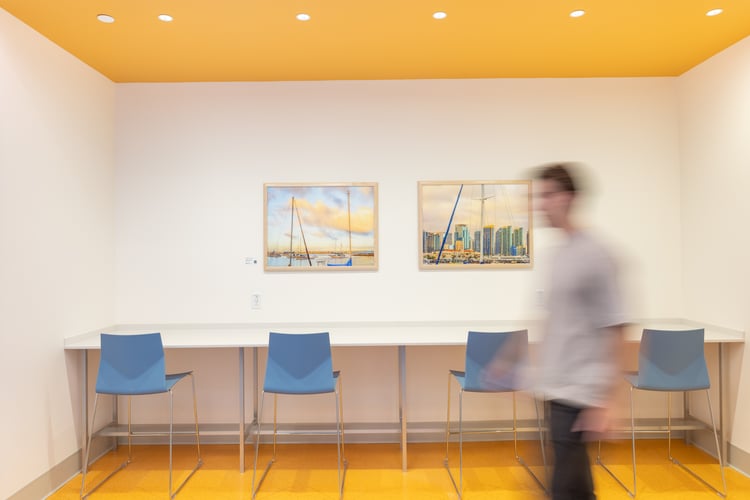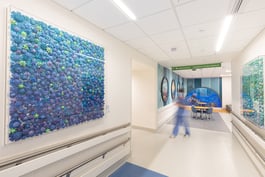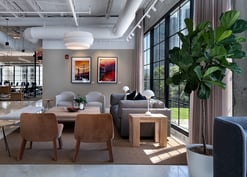Healthcare design trends and strategies are constantly evolving, and the conversations at this year’s Healthcare Design Conference (HCD) highlighted a continued trajectory towards embracing technology, art, and adaptability to create human-centered environments. The tone across sessions and discussions reflected a recognition that the physical environment plays a central role in resilience, restoration, and connection. With this increased understanding of holistic ecosystems of care, today’s healthcare spaces are designed to support the emotional well-being of everyone who uses them, including patients, caregivers, staff, and visitors.
This year’s discussions emphasized how improved emotional well-being supports outcomes for patients and staff, highlighting design strategies that consider how a space makes us feel.
Across many sessions, there were action-oriented discussions on staff burnout, multi-sensory environments, holistic behavioral healthcare design, and how the design landscape is embracing and growing with advancing technologies. Additionally, conversations revealed increasing acknowledgment of art as an essential component of healing environments. These themes suggest that the role of healthcare environments is shifting: medical spaces are not simply places where treatment occurs, but where care is felt as a supportive and emotionally intelligent network.
Designing for Staff Wellbeing
One of the most prominent themes from this year’s conference was the importance of designing to support caregivers. Staff burnout was not discussed as a workforce challenge, but as an environmental one that strategic design interventions can address.
Spaces that offer staff moments of quiet, emotional decompression, or a chance to pause from the demanding pace of clinical work were presented as a critical component of a healthy care environment. Acknowledging that staff require restoration to effectively support patients reinforces the need for holistic thinking in healthcare design and operational strategies. A well-designed space not only encourages efficiency and safety but also communicates respect and empathy. This connection was emphasized repeatedly, as when staff are supported, the quality of care is strengthened.
Sensory Design and Evolving Behavioral Healthcare Spaces
Behavioral healthcare remained a central focus throughout the conference, with discussions emphasizing the need for sensory-aware design in spaces supporting diverse patient populations. One panel hosted by the International Interior Design Association (IIDA), “Care Redefined, How Design is Shaping the Future of Healthcare,” highlighted the balance between overstimulation and understimulation, recognizing that both extremes can escalate discomfort or anxiety.
Sensory design is a crucial component of care, specifically in behavioral healthcare contexts. Lighting, texture, acoustics, and visual elements were discussed in terms of how they influence emotional regulation and feelings of comfort and safety. Creating environments that feel responsive and attuned to sensory sensitivity can encourage self-soothing, particularly in behavioral health contexts (Malhotra & Abrol, 2024).
The conversations at HCD this year made it clear that sensory-responsive environments are foundational to the healing process and will characterize the future of healthcare design. In addition to designing for diverse needs, many conversations also explored the potential of adaptable environments that can shift as circumstances change, rather than creating static spaces with singular purposes. These flexible solutions signal a broader shift toward environments that grow with patient and staff needs over time.
Technology & AI
Conversations at HCD centered on leveraging tools such as AI to enhance efficiency while maintaining a human-centered approach to care as technology advances. AI tools are becoming increasingly embedded in the healthcare system. Historically human processes have been taken over by tech, such as scheduling chatbots, automated check-ins, and computer-generated communications. The session, “More Human Healthcare: AI and the Patient Experience,” explored how the industry can integrate innovation without compromising the warmth and character patients rely on.
While advanced technology and growing AI tools can streamline processes, increase accessibility, and reduce operational strain, they also reshape how people experience care. When interactions shift from human to digital, the surrounding environment becomes more responsible for conveying comfort, trust, and connection. The impact of technology ultimately depends on thoughtful integration into environments that are intentionally designed to soften the increasingly digital care system (Papadakos & Constantine, 2025). .jpg?width=1000&height=666&name=TBP_2122%20(1).jpg)
The Expanding Role of Art in Healthcare Environments
This year’s discussions also revealed a noticeable increase in the visibility and importance of art in healthcare spaces. In another panel hosted by IIDA, “Designed for Joy: Elevating Human Health and Experience in Healthcare Spaces,” art was described as the common thread that ties together emotional and sensory experiences within an environment. Additionally, conversations extending beyond interior design recognized art as a meaningful contributor to fostering comfort and affirming identity, and in the panel “Designed for Joy,” art was identified as a strategic tool for bringing warmth into healthcare spaces and enhancing staff well-being.
Art can reinforce community connection, provide opportunities for engagement, and serve as a positive distraction. It also contributes to shaping environments that feel welcoming and thoughtful (Palityka & Chrysikou, 2024). The sessions and conversations at HCD 2025 indicated that the industry is embracing art as an emotional infrastructure and an integral part of human-centered design.
How TurningArt Helps Shape Human-Centered Spaces
We were excited to see how closely the themes that emerged at HCD 2025 align with our mission to create environments that center emotional experience and support intentional healing. By partnering with healthcare teams to understand the needs of a space, we help bring these insights to life.
By curating art that promotes calm and connection, TurningArt helps healthcare organizations design spaces that reflect the people who use them and support both emotional well-being and functional care delivery..jpg?width=750&height=500&name=TBP_2177-Edit%20(1).jpg)


Connect with an Art Advisor below to learn more!

.jpg?width=332&height=177&name=_MG_0840%20copy%20(2).jpg)


.jpg?width=332&height=177&name=dtBv_067_DSC_2139_DaNil%20(2).jpg)


